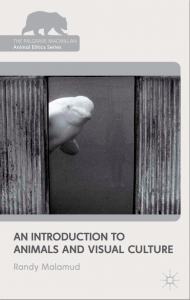Latest news
Fellow Publishes Pioneering Work on Animals in Visual Culture
28th July 2012
 This month sees the publication of the groundbreaking work An Introduction to Animals and Visual Culture by Centre Fellow Professor Randy Malamud.
This month sees the publication of the groundbreaking work An Introduction to Animals and Visual Culture by Centre Fellow Professor Randy Malamud.
In the first introduction to the field, Professor Malamud provides a fascinating and challenging examination of how people “frame” other animals in a variety of cultural media, and what the implications are for both the observer and the observed
How and why do people “frame” animals so pervasively, and what are the ramifications of this habit? For animals, being put into a cultural frame (a film, a website, a pornographic tableau, an advertisement, a cave drawing) means being taken out of their natural context, almost always resulting in a less happy outcome for the animal. People’s vision of the animal equates to power over the animal. How do we see animals in visual culture? And what other (better) ways might there be to see them, or even more challengingly, to not see them? We envision ourselves as monarchs of all we survey, but our record shows that we are indeed not masters of the ecosphere, so a more ethically accurate stance in our relationship to animals should challenge the omnipotence of our visual access to them.
An excerpt from the book entitled “Vengeful Tiger, Glowing Rabbit” has been published in the Chronicle of Higher Education on 26th July. It can be read here.
Professor Randy Malamud is Professor of English and Chair of the Department of English at Georgia State University, Atlanta, GA. He is the author of Reading Zoos: Representations of Animals and Captivity (Macmillan and NYU Press, 1998) and Poetic Animals and Animal Souls (Palgrave Macmillan, 2003), and the editor of A Cultural History of Animals in the Modern Age (Berg, 2007). See his webpage for further details.
More information about the book is here and information about the Palgrave Macmillan Series on Animal Ethics published in partnership with the Centre is here.